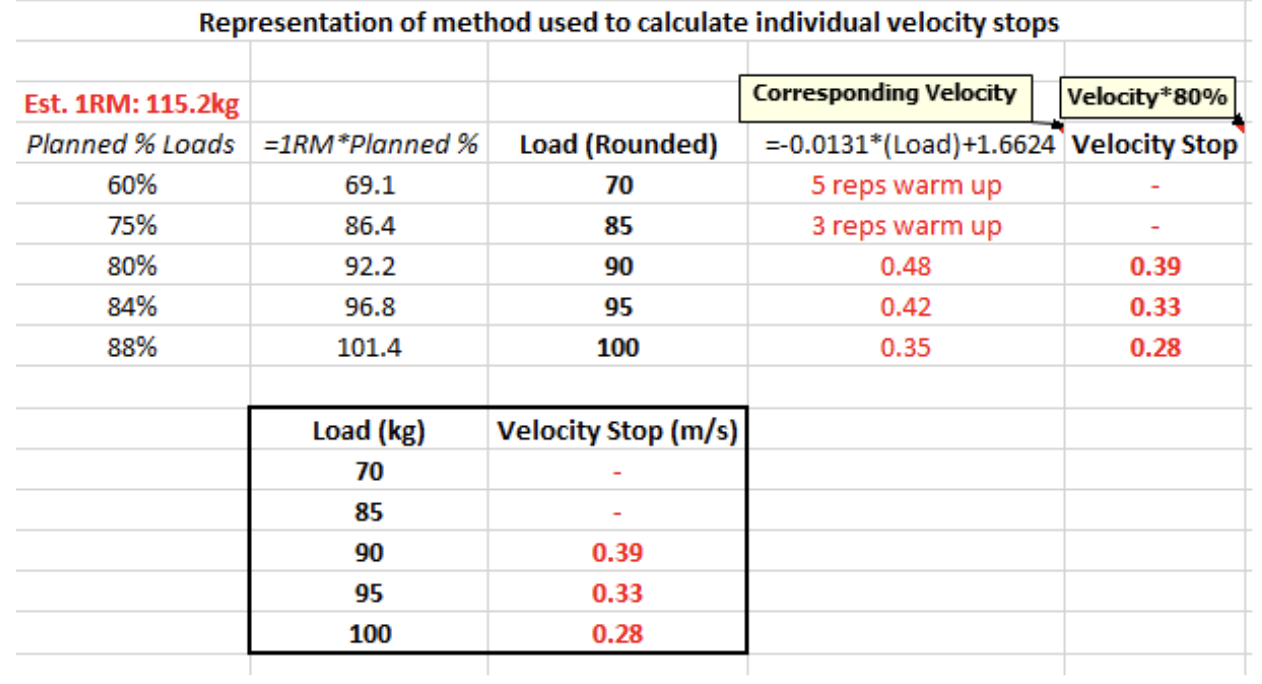Velocity Based Training
The Load-Velocity Relationship
Without overstating the obvious, as the load increases (with the intent to lift it as fast as possible) the speed decreases in a linear fashion 14. This is a fundamental tenet on which Velocity based training (VBT) principles operate – the load-velocity relationship. The relationship between load and velocity in simple strength exercises such as the squat and bench press is extremely stable and very strong1,4,7. The relationship holds true regardless of strength level and after increases or decreases in strength 4. Irrespective of strength level or experience, the load-velocity relationship holds true and is at the core of VBT methods for maximal strength development.
The Minimum Velocity Threshold
As the load in a lift progresses or the number of reps in a set increase, at some point, the weight will be too heavy and the athlete will fail; essentially they won’t be able to move the load at a sufficient speed to overcome gravity. The last successful rep in a maximum effort set is therefore associated with a specific minimum velocity in order to be successful, anything below this would result in a failed rep. This is another core principle of VBT. This value, termed the minimal velocity threshold (MVT), remains stable regardless of strength level and is true irrespective of the number of reps performed. Izquierdo et al 6 reported in sets to failure in both the bench press and squat, no significant difference between the average absolute velocities attained during the last repetition completed during sets at 75%, 70%, 65% and 60% of 1RM. In the example below, you can see that as the load increases in the 1RM Bench Press test or as the reps increase in an 80% 1RM max reps effort, the velocity decreases in a linear fashion to the same MVT. In the case of this athlete, their individual MVT appears to be 0.19 m.s⁻¹.
An important point to note is that the MVT varies by exercise 14. There is a consensus in the literature that the MVT for
Bench press is approximately 0.15 m.s⁻¹.
Squat is approximately 0.27 – 0.30 m.s⁻¹ 2, 6,
Knowledge of the specific velocity characteristics of key strength exercises is vital for using velocity to predict 1RM based off sub-maximal loads or understanding how close to failure an athlete may be in a lift.
These two fundamental principles; the relationship between load and velocity and the MVT of core strength exercises are central to implementing VBT methods in strength training.
Gauging effort and managing progressive overload
Undoubtedly the easiest to implement, and possibly the most successful strategy we have employed, has been to determine how taxing a set has been. Let’s say in the bench press, if an athlete has built up to a heavy set of five reps, the further away the velocity outputs for those reps are from the MVT (0.15 m.s⁻¹), the easier that set was.
It has been well documented 1,9 that when an athlete is given velocity or power feedback, their output increases. I believe that the intent improves across all sets, including build up sets, and hence the overall quality is improved as athletes produce more force (from a higher acceleration in F=MA) across more of their sets.
Estimating 1RM from sub-maximal loads
Perhaps one of the most well-known benefits of VBT is the ability to estimate 1RM from sub-maximal loads. The strength of the relationship between load and velocity means that we can, with a degree of accuracy, use one variable to estimate the other (provided that maximal intent to lift fast is applied and we know the MVT of the exercise). This is a valuable method to gauge the strength of an athlete without exposing them to the risk of maximal loads. We have found this useful with young or inexperienced lifters, For simplicity, only the estimation of 1RM is presented below.
The use of the load-velocity relationship to estimate 1RM appears accurate and in most cases, corresponds closely to the actual strength level of most of our players. Jidovtseff et al 7 postulate that predictions from the load-velocity relationship are at least as accurate as the reps to failure method.
Predicting elite athletes 1RM’s from the load-velocity relationship is more reliable due to how frequently they train at a high intensity of loading, therefore the estimation should be more accurate.
Controlling fatigue and level of effort
It is well established that training to repetition failure (maximum effort) does not necessarily improve the magnitude of strength gains 3. In fact it may even be counterproductive, with excessive fatigue leading to greater mechanical and metabolic strain, a reduction in muscle force production, RFD and power output 5,13. One method to mitigate this is to set a velocity loss threshold which could avoid performing unnecessary reps that may not be contributing to the desired training effect. Researchers have recommended terminating a set after a certain % velocity loss from the first (and usually fastest) rep, 30% in the squat and 35% in the bench press. We have found this to generally work well, especially as the percentage drop value is often a convenient readout in most devices, but its success ultimately hinges on the athlete giving maximal intent on the first and all reps.
We have implemented a similar concept whereby the set is terminated when repetition velocity drops below a pre-determined velocity stop value. This number that is generated from the load-velocity data will be what that athlete should be able to hit with maximal effort. We have used 80% of the full value as a cut-off velocity with good results. So for instance, if lifting a relative intensity of 75% of 1RM in the bench press, the expected speed from a typical load-velocity profile might be 0.7 m.s⁻¹, therefore, the velocity stop would be 80% of this which is 0.56 m.s⁻¹. The player would then lift as many reps as possible until the speed drops below 0.56 m.s⁻¹. This approach is more practical than the percentage drop off method as it allows for some reps that may not be at absolute maximal intent, which will happen, but would otherwise skew the calculation of the percentage decrease in velocity and perhaps terminate a set too early.
By using a cut-off velocity and allowing the athletes to maximise reps above this value, in sessions where they are fresh, more reps will naturally be performed. Conversely, when fatigue is higher, reps will be lower. What is important is that proximity to failure is stable, regardless of physical readiness. As such, the use of velocity measuring almost acts as a form of autoregulation, but without relying solely on the feeling of the player.
Despite less volume in this method than traditional training, the magnitude of strength improvements is considerable and potentially much higher than training to failure. The benefits of maximising rep speed compared to self-selected speeds was explored in a training study by Padulo et al 11. An experienced group of lifters were split into two groups and trained twice per week with 85% 1RM load in the bench press. The first group lifted with a fixed pushing speed with a velocity of 80-100% maximal speed and were stopped when velocity dropped by 20%. Sets continued until they couldn’t hit the minimum velocity. The second group lifted with a self-selected speed to failure on all sets until forced exhaustion. Rest between sets was the same between groups. After three weeks, the fixed speed group increased 1RM strength by 10.2% with greater EMG activation of working muscles compared to 0.17% in the self-selected speed group. The fixed speed group did about two thirds of the overall volume of the self-selected group. The only difference between groups was speed of lifting which highlights the importance of movement velocity in determining the neuromuscular response to training. So despite in the majority of cases where we utilise VBT, not lifting to repetition maximum, the player is lifting with maximum velocity which in itself is perhaps just as intense. The greater activation of the neuromuscular system as a result, is undoubtedly one of the key reasons behind the effectiveness of VBT. In environments where the use of velocity measuring devices is not feasible, similar improvements could be garnered by emphasising maximal speed of movement along with the appropriate selection of load with respect to level of effort.
Padulo et al 11 recommend that VBT is more suited to experienced lifters with traditional methods more appropriate for novice athletes as a means to become familiar with technique and to improve the muscle tendon adaptation to a specific exercise. This is important to remember as the addition of velocity based measures adds a new dimension of intensity which may be unsuitable to certain individuals or at certain times. However, in the vast majority of cases, the advantages of VBT far outweigh the potential disadvantages. The use of VBT methods ultimately minimises the fatigue effect of the strength training stimulus, while maximising the performance aspect, which in a holistic rugby training programme where the strength training is but one component, is undoubtedly a substantial benefit of utilising VBT.
References
Bosquet, L, Porta-Benache, J and Blais, J. Validity of a commercial linear encoder to estimate bench press 1RM from the force-velocity relationship. J Sports Sci and Med 9, 459-463, 2010.
Conceicao, F, Fernades, J, Lewis, M, Gonzalez-Badillo, JJ and Jimenez=Reyes, P. Movement velocity as a measure of exercise intensity in three lower limb exercises. J Sports Sci [Epub ahead of print], 2015.
Folland, JP, Irish, CS, Roberts, JC, Tarr, JE and Jones, DA. Fatigue is not a necessary stimulus for strength gains during resistance training. Br J Sports Med 36: 370-74, 2002.
Gonzalez-Badillo, JJ and Sanchez-Medina, L. Movement velocity as a measure of loading intensity in resistance training. Int J Sports Med 31:347-52, 2010.
Gonzalez-Badillo, JJ, Marques MC and Sanchez-Medina, L (2011). The importance of movement velocity as a measure to control resistance training intensity. Journal of Human Kinetics, Special Issue 2011, 15-19.
Izquierdo, M, Gonzalez-Badillo, JJ, Hakkinen, K, Ibanez, J, Kraemer, WJ, Altadill, A, Eslava, J and Gorostiaga, EM. Effect of loading on unintentional lifting velocity declines during single sets of repetitions to failure during upper and lower extremity muscle actions. Int J Sports Med 27, 718-724, 2006.
Jidovtseff, B, Harris, NK, Crielaard, JM and Cronin, JB. Using the load-velocity relationship for 1RM prediction. J Strength Cond Res 25(1), 267-270, 2011.
Jovanovic, M and Flanagan, EP. Researched applications of velocity based strength training. J Aust Strength Cond 22: 59-69, 2014.
Keller, M, Lauber, B, Gehring, D, Leukel, C and Taube, W. Jump performance and augmented feedback: Immediate benefits and long-term training effects. Human Movement Sci 36, 177-189, 2014.
Mann, B. Developing Explosive Athletes: Use of Velocity Based Training in Training Athletes. Michigan: Ultimate Athlete Concepts, 2016.
Padulo, J, Mignogna, P, Mignardi, S, Tonni, F and D’Ottavio, S. Effect of different pushing speeds on bench press. Int J Sports Med 33: 376-80, 2012.
Randell, AD, Cronin, JB, Keogh, JW, Gill ND and Pedersen, MC. Effect of instantaneous performance feedback during 6 weeks of velocity-based resistance training on sport-specific performance tests. J Strength Cond Res 25: 87-93, 2011.
Sanchez-Medina, L and Gonzalez-Badillo, JJ. Velocity loss as an indicator of neuromuscular fatigue during resistance training. Med Sci Sports Exerc 43:1725-34, 2011.
Sanchez-Medina, L, Gonzalez-Badillo, JJ, Perez, CE and Pallares, JG. Velocity-and power-load relationships of the bench pull vs. bench press exercises. Int J Sports Med 35: 209-16, 2015.






